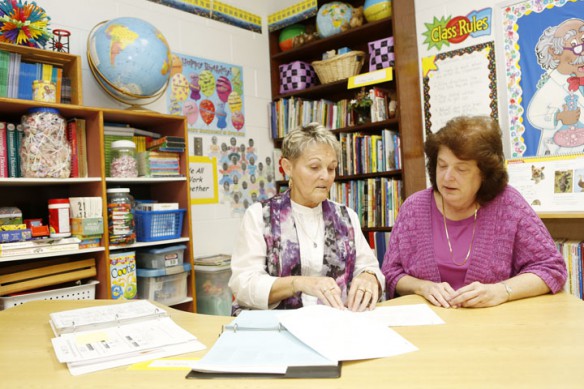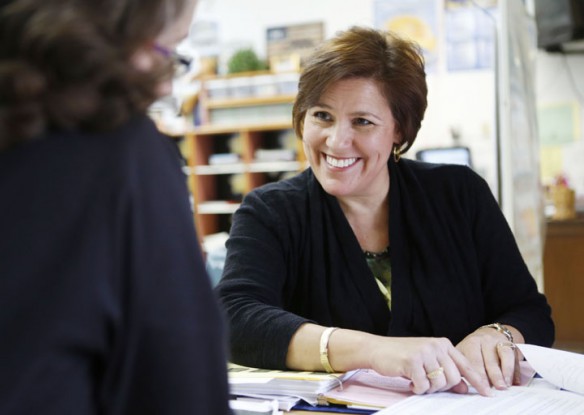
Second-grade teacher Carolyn Noe, left, reviews the peer observation she did in 1st-grade teacher Sharon Clark’s language arts class at Paint Lick Elementary School (Garrard County). Clark said the observation was very helpful and prepared her for her evaluation with her principal.
Photo by Amy Wallot, Nov. 5, 2012
- The Kentucky Department of Education, along with several partners and more than 50 school districts, is in the third year of a four-year plan to develop the Professional Growth and Effectiveness System (PGES). Schools statewide will pilot the new system in the 2013-14 school year, with full implementation scheduled for 2014-15. This is the first in a series of stories that will examine different aspects of the proposed system.
By Matthew Tungate
matthew.tungate@education.ky.gov
Teachers and principals across Kentucky are developing and testing a system that will provide them individualized feedback and professional growth opportunities that will make them stronger educators and help their students meet the state’s college- and career-readiness goals.
“We, in Kentucky, are focused on every student in every classroom having a highly effective teacher and ensuring that every school is led by a highly effective leader,” said Cathy White, manager of the Teacher and Leader Effectiveness Branch of the Kentucky Department of Education (KDE).
Kentucky’s ultimate goal is that every child is proficient and graduates high school college- and/or career-ready.
“That doesn’t happen magically because you walk through the doors of a school building,” said White, noting that research shows a teacher is the most influential factor for student growth in the classroom. “There have to be adults in that building who purposefully and intentionally plan for and engage students in specific experiences that enable them to learn and grow and achieve at their highest level of ability.”
To ensure every school has effective educators who can do that, KDE is developing the Teacher and Principal Professional Growth and Effectiveness System (PGES). The statewide system is designed to be a fair and equitable and uses multiple measures of effectiveness including student growth, professional growth, student voice, self-reflection and observations in the evaluation process.
Current systems do not provide consistent, evidence-based feedback to teachers or a comprehensive approach that promotes continuous professional learning focused on improved practice and increased student achievement, White said.
Developing and adopting a new teacher and principal evaluation and support system is one of the requirements of Kentucky’s No Child Left Behind waiver. Among other things, it mandates the new system be based on continuous instructional improvement and regular evaluation, use at least three performance levels and provide clear and timely feedback including opportunities for professional development.
This school year, more than 50 districts across the state are field testing PGES and providing feedback to two steering committees – one for principals and one for teachers. The steering committees are charged with making recommendations to the Kentucky Board of Education regarding development of PGES.
The committees include representatives from the Kentucky Education Association, Jefferson County Teachers Association (JCTA), Kentucky Association of School Administrators, Kentucky Association of School Superintendents, Kentucky School Boards Association, Kentucky Parent Teacher Association, the Prichard Committee for Academic Excellence, and practicing teachers and principals.
“We have involved our stakeholders in the development of the system to truly give everybody a voice,” White said.
The teacher steering committee recommended the Danielson Framework for Teaching to measure whether teachers are effective. White said the Danielson framework focuses on four areas, or domains: planning and preparation; classroom environment and climate; instruction; and professional responsibility. Those four domains, along with a fifth measuring student growth, account for the overall rubric called the Kentucky Framework for Teaching.
KDE is following the work of the Bill and Melinda Gates Foundation’s Measures of Effective Teaching (MET) project in determining what measures have been seen as valid in determining effectiveness.
Garrard County Superintendent Donald Aldridge said he volunteered his district for the field test for the same reason many people vote – if he didn’t participate, he’d have no right to complain about the outcome.
“The stress that we’re going through is going to help the whole system, and it’s going to help make it right,” he said.
While the system still needs refining, Aldridge likes two aspects in particular. One is that principals are required to receive training and be certified to observe teachers.
“I think any system of evaluation is effective if you’ll do honest evaluation and give your evaluatees constructive feedback,” he said. “If you’re not honest with them, I don’t think any system is going to be effective.”
Aldridge said the training “really made me look at when I evaluated teachers, how I’d look at things differently now if I was back doing the principal’s role.”
The other aspect Aldridge likes is that information gathered as part of PGES is recorded in the Continuous Instructional Improvement Technology System (CIITS).
“So professional development is right at your desktop for anything that you need,” he said.

Third-grade teacher Sherri Davis, right, reviews a peer observation with ELA teacher Tara Lewis at Paint Lick Elementary School (Garrard County). Peer observations are used only to improve practice and are not evaluative under the Professional Growth and Effectiveness System (PGES).
Photo by Amy Wallot, Nov. 5, 2012
At Paint Lick Elementary School (Garrard County), Principal Larry Sparks has two teachers who are being evaluated and two teachers who serve as peer observers as part of the field test. Sparks said they received training during the 2011-12 school year and over the summer.
Third-grade teacher Sherri Davis has been observed by Sparks, had a peer review, worked on goals as part of student growth and does weekly professional reflection.
Davis said PGES documentation requirements can seem unnecessary, but they help teachers stay focused on increasing student achievement.
“It makes you more aware of what you are doing. Sometimes you do things every day, and we’re not real specific about it – we know we’re doing it, but we’re not jotting it down and calling it a certain thing,” Sparks said. “This makes you more aware of that.”
Peer observer Carolyn Noe, a 2nd-grade teacher, said she has increased respect for what a principal does during an observation after having gone through it herself. Peer observations are not meant to be evaluative, only formative, so teachers can honestly review their colleagues and discuss with each other what they have found.
“As teachers we sometimes say that we should probably apologize to the students we had as a beginning teacher. Experience refines our rough edges,” she said. “However, if there had been something like PGES to guide me, I believe I would have been a better teacher in those early years.”
She also is glad to know that teachers are helping develop PGES.
“It’s going to be easy and specific to manage,” she said. “So I think in the long run teachers will appreciate it.”
White said PGES supports continuous growth for teachers so they can support student learning while improving themselves.
“It allows teachers to continually adjust their professional practice in such a way that it grows them in their craft, ultimately, to be even better professionals who are more equipped to meet the needs of students, she said.
MORE INFO …
Cathy White, cathy.white@education.ky.gov, (502) 564-1479, ext. 4019


Leave A Comment